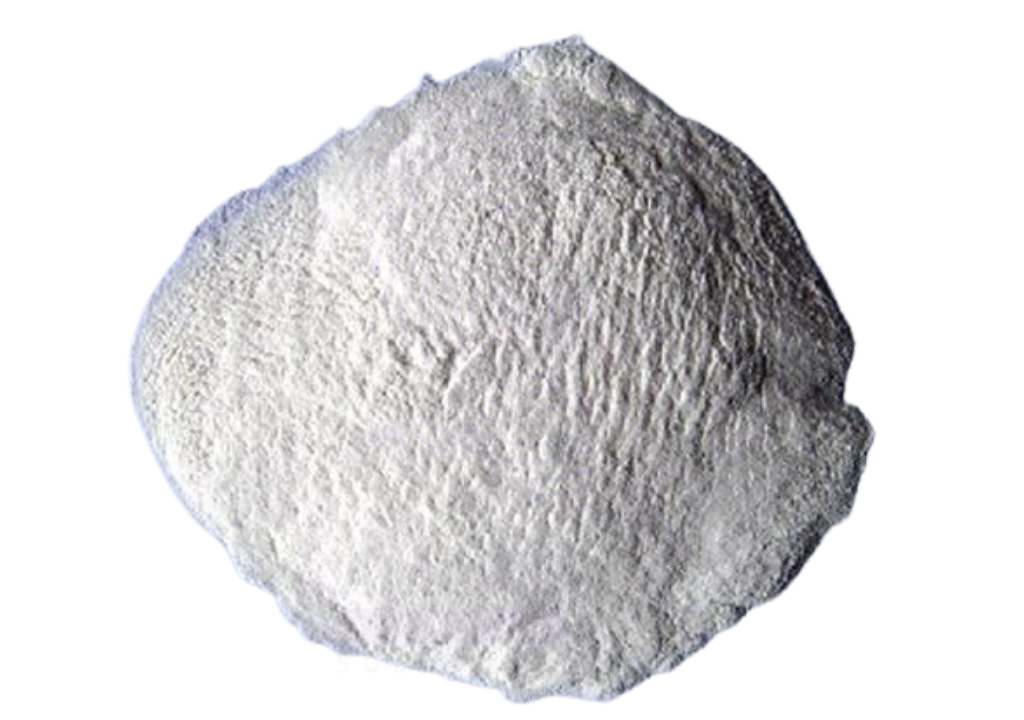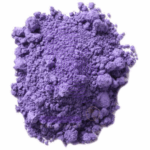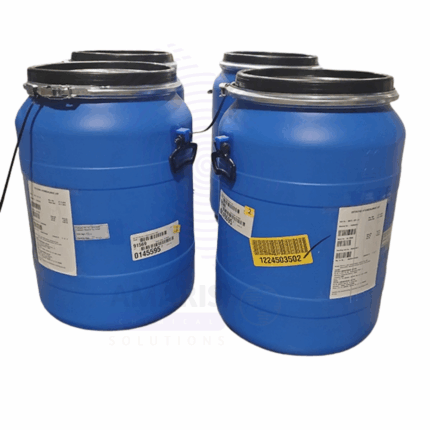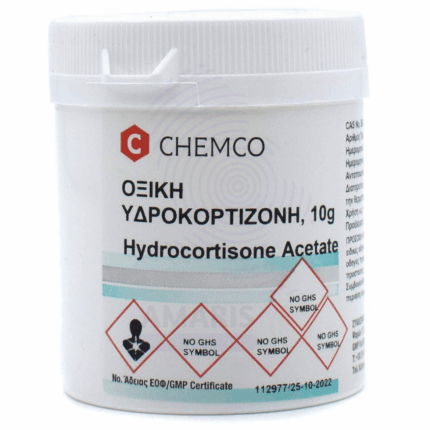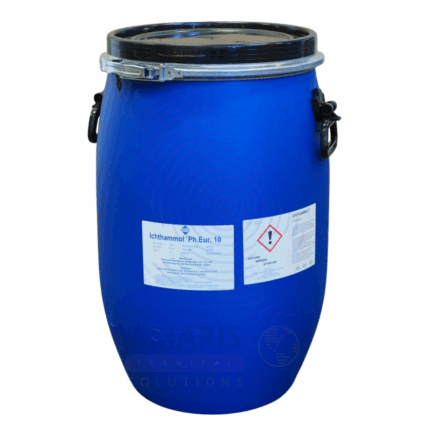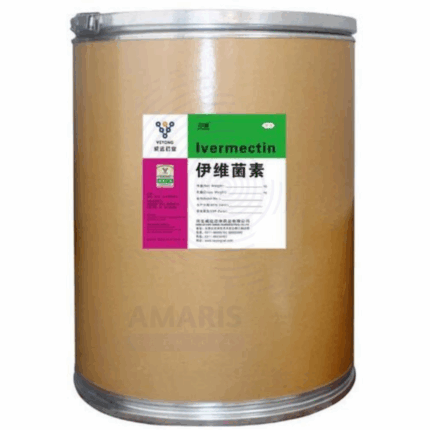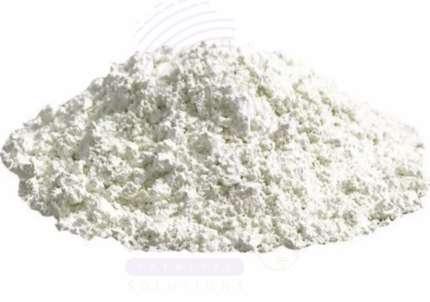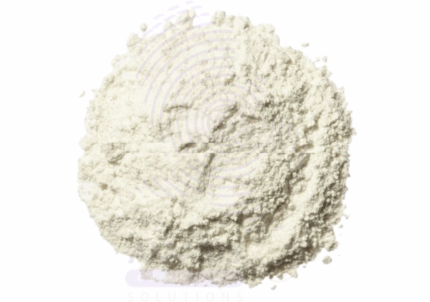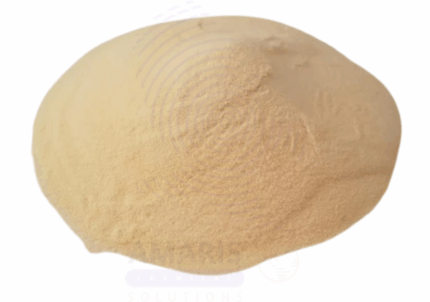Back to products
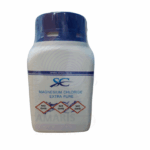

Magnesium Chloride Extra Pure
$ 17.30 Original price was: $ 17.30.$ 17.23Current price is: $ 17.23.
Cyclopentolate HCL
Whatsapp Order
Cyclopentolate Hydrochloride (HCL) is a synthetic anticholinergic agent used primarily in ophthalmology. It appears as a white to off-white crystalline powder, soluble in water, with a slightly bitter taste. Cyclopentolate HCL works by temporarily paralyzing the muscles of the eye’s ciliary body and iris, causing pupil dilation (mydriasis) and paralysis of accommodation (cycloplegia). It is commonly formulated into eye drops for diagnostic procedures and therapeutic applications involving the eye.
Description
Table of Contents
Toggle
Cyclopentolate HCL Uses
Primary Uses
- Ophthalmic Diagnostics and Therapeutics
- Used as a mydriatic and cycloplegic agent to dilate pupils during eye examinations.
- Facilitates accurate measurement of refractive errors by temporarily paralyzing accommodation.
- Employed to treat uveitis and other inflammatory conditions of the eye by reducing muscle spasms and pain.
- Used in preparation for ocular surgeries and diagnostic procedures such as fundoscopy.
- Pharmaceutical Formulations
- Incorporated in eye drop formulations for controlled, topical delivery to the eye.
- Used in combination with other ophthalmic agents for therapeutic regimens addressing eye inflammation and injury.
Secondary Uses
- Research Applications
- Utilized in pharmacological research to study autonomic nervous system responses and ocular pharmacodynamics.
- Applied in experimental models investigating mechanisms of cycloplegia and mydriasis.
- Compounding Pharmacy
- Used by compounding pharmacies to prepare custom ophthalmic solutions with specific concentrations tailored to patient needs.
KEY PRODUCT FEATURES
1. Basic Identification Attributes
- Chemical Name (IUPAC): (RS)-2-(Dimethylamino)ethyl 1-cyclopentyl-1-phenyl-1,3-dioxan-5-ylcarboxylate hydrochloride
- Common/Trade Name: Cyclopentolate Hydrochloride (Cyclopentolate HCL)
- CAS Number: 522-20-7
- HS Code: 2941.90.90
- Molecular Formula: C17H25NO3·HCl
- Synonyms:
- Cyclopentolate HCl
- Cyclopentolate Hydrochloride
2. Physical & Chemical Properties
- Physical State: White to off-white crystalline powder
- Color & Odor: White/off-white; odorless
- Melting Point: 135–138°C (decomposes)
- Boiling Point: Not applicable (decomposes before boiling)
- Density: Not applicable (solid powder)
- Solubility:
- Freely soluble in water
- Slightly soluble in alcohol and acetone
- Stability: Stable under normal conditions; hygroscopic
3. Safety & Hazard Attributes
- Hazard Class (GHS): Not classified as hazardous under normal use; may cause irritation
- NFPA Ratings:
- Health: 1
- Flammability: 0
- Reactivity: 0
- Exposure Limits: No established occupational exposure limits; handle with care
- Toxicity: Toxic if ingested in large amounts; may cause anticholinergic side effects (dry mouth, tachycardia, blurred vision) if systemically absorbed
- Reactivity: Stable; avoid strong oxidizing agents
4. Storage & Handling Attributes
- Storage Conditions: Store in a cool, dry place protected from light and moisture
- Container Type: Airtight, light-resistant containers
- Shelf Life: Typically 2–3 years if stored properly
- Special Handling: Avoid inhalation of dust; use PPE (gloves, masks) during handling
5. Regulatory & Compliance Attributes
- FDA Status: Approved for ophthalmic use as per pharmaceutical regulations
- REACH Status: Registered chemical substance for pharmaceutical use
- Transportation: Not classified as hazardous for transport
- Waste Disposal: Dispose according to pharmaceutical waste guidelines; avoid environmental contamination
6. Environmental & Health Impact
- Ecotoxicity: Low environmental impact; avoid release into waterways
- Persistence: Not persistent in the environment; degrades under normal conditions
- Bioaccumulation: Not expected to bioaccumulate
- Carcinogenicity/Mutagenicity: No evidence of carcinogenicity or mutagenicity
- Biodegradability: Expected to be biodegradable
SAFETY HANDLING PRECAUTIONS
Safety Handling Precautions
Personal Protective Equipment (PPE):
- Protective gloves
- Dust mask or respirator (to avoid inhalation of powder)
- Safety goggles
Handling Measures:
- Avoid dust formation and inhalation
- Use in well-ventilated areas
- Avoid contact with skin and eyes
Storage Measures:
- Keep containers tightly closed
- Store in a cool, dry place away from light and moisture
Hygiene Practices:
- Wash hands thoroughly after handling
- Avoid eating, drinking, or smoking during handling
First Aid Measures
- Inhalation: Move person to fresh air; if breathing difficulty occurs, seek medical attention.
- Skin Contact: Wash affected area with soap and water; seek medical advice if irritation develops.
- Eye Contact: Rinse eyes immediately with plenty of water for at least 15 minutes; seek medical attention if irritation persists.
- Ingestion: Do not induce vomiting; seek immediate medical assistance.
Firefighting Measures
- Fire Hazards: Not highly flammable but may decompose on heating producing toxic fumes.
- Extinguishing Media: Use water spray, foam, dry chemical, or carbon dioxide.
- Special Precautions: Firefighters should wear protective equipment and self-contained breathing apparatus.
- Decomposition Products: May emit toxic gases such as nitrogen oxides and hydrochloric acid.
Related products
Cetirizine Dihydrochloride
Cetirizine Dihydrochloride is a second-generation antihistamine widely used to relieve allergy symptoms such as hay fever, urticaria (hives), and other allergic conditions. It is the dihydrochloride salt form of cetirizine, presenting as a white to off-white crystalline powder that is odorless or nearly odorless and slightly bitter in taste. Cetirizine Dihydrochloride acts as a selective antagonist of peripheral H1 histamine receptors, preventing the effects of histamine and thereby reducing allergic symptoms without causing significant sedation. It is a commonly prescribed active pharmaceutical ingredient (API) in oral tablets, syrups, and capsules.
Chlorpheniramine Maleate
Chlorpheniramine Maleate is a first-generation alkylamine antihistamine used primarily to relieve allergy symptoms by blocking H1 histamine receptors. It appears as a white or off-white crystalline powder, freely soluble in water and alcohol. Known for rapid onset and moderate duration of action, it’s widely formulated in pharmaceuticals. It also exhibits mild anticholinergic and sedative effects.
Hydrocortisone Acetate
Hydrocortisone Acetate is a synthetic corticosteroid ester derived from hydrocortisone (cortisol). It is a white to off-white crystalline powder, practically insoluble in water but soluble in alcohol and acetone. This compound exhibits potent anti-inflammatory, immunosuppressive, and anti-allergic properties, making it widely used in pharmaceutical and dermatological formulations. Hydrocortisone Acetate acts by modulating gene expression to reduce the production of inflammatory mediators, thereby alleviating symptoms in various inflammatory and autoimmune conditions.
Ichthammol BP98
Ichthammol BP98, also known as ammonium bituminosulfonate, is a dark brown to black, viscous, sulfur-rich, semi-solid substance derived from the distillation of shale or bituminous rocks. It has a characteristic tar-like odor and is highly valued in pharmaceutical and dermatological applications for its anti-inflammatory, antiseptic, antipruritic (anti-itch), and keratolytic properties. Ichthammol penetrates deeply into the skin and soft tissues, helping to alleviate inflammation and promote healing. It is widely used in topical preparations for treating skin conditions such as eczema, psoriasis, boils, abscesses, and other dermatological infections.
Ivermectin BP Vet
Ivermectin BP Vet is a potent, broad-spectrum antiparasitic agent widely used in veterinary medicine. It belongs to the avermectin family and works by disrupting nerve and muscle function in parasites, leading to paralysis and death. Ivermectin is highly effective against a range of internal and external parasites, including gastrointestinal worms, lungworms, mites, lice, and certain ticks. Available in oral, injectable, and topical forms, it is trusted for use in livestock, poultry, and companion animals. Its reliable efficacy, wide safety margin, and ease of administration make it an essential treatment in animal health and parasite control programs.
Mepyramine Maleate BP
Mepyramine Maleate BP is an antihistamine drug commonly used to relieve allergic symptoms such as hay fever, urticaria, and other allergic reactions. It works by blocking histamine H1 receptors, reducing allergic responses like itching, swelling, and redness. This compound is a white or off-white crystalline powder, soluble in water and alcohol, widely used in pharmaceutical formulations including tablets, creams, and injectables.
Neomycin Sulphate BP Oral
Neomycin Sulphate BP Oral is an aminoglycoside antibiotic derived from Streptomyces fradiae. It is used primarily for treating infections caused by susceptible aerobic gram-negative and some gram-positive bacteria. The oral form is especially utilized for intestinal antisepsis, to reduce bacterial flora before gastrointestinal surgery, or to treat hepatic encephalopathy by decreasing ammonia-producing bacteria in the gut. It is available in powder or tablet form conforming to British Pharmacopoeia (BP) standards, ensuring high purity and efficacy.
Norfloxacin
Norfloxacin is a synthetic broad-spectrum fluoroquinolone antibiotic used primarily to treat bacterial infections. It works by inhibiting bacterial DNA gyrase and topoisomerase IV, enzymes essential for DNA replication, transcription, repair, and recombination, leading to bacterial cell death. Norfloxacin is effective against various Gram-negative and some Gram-positive bacteria and is commonly used in urinary tract infections, prostatitis, and gastroenteritis.


 Preservatives(food)
Preservatives(food) Flavor Enhancers
Flavor Enhancers Acidulants
Acidulants Sweeteners
Sweeteners Antioxidants
Antioxidants Colorants(food)
Colorants(food) Nutraceutical Ingredients (food)
Nutraceutical Ingredients (food) Nutrient Supplements
Nutrient Supplements Emulsifiers
Emulsifiers
 Collectors
Collectors Dust Suppressants
Dust Suppressants Explosives and Blasting Agents
Explosives and Blasting Agents Flocculants and Coagulants
Flocculants and Coagulants Frothers
Frothers Leaching Agents
Leaching Agents pH Modifiers
pH Modifiers Precious Metal Extraction Agents
Precious Metal Extraction Agents
 Antioxidants(plastic)
Antioxidants(plastic) Colorants (Pigments, Dyes)
Colorants (Pigments, Dyes) Fillers and Reinforcements
Fillers and Reinforcements Flame Retardants
Flame Retardants Monomers
Monomers Plasticizers
Plasticizers Polymerization Initiators
Polymerization Initiators Stabilizers (UV, Heat)
Stabilizers (UV, Heat)
 Antifoaming Agents
Antifoaming Agents Chelating Agents
Chelating Agents Coagulants and Flocculants
Coagulants and Flocculants Corrosion Inhibitors
Corrosion Inhibitors Disinfectants and Biocides
Disinfectants and Biocides Oxidizing Agents
Oxidizing Agents pH Adjusters
pH Adjusters Scale Inhibitors( water)
Scale Inhibitors( water)
 Antioxidants(cosmetic)
Antioxidants(cosmetic) Emollients
Emollients Fragrances and Essential Oils
Fragrances and Essential Oils Humectants
Humectants Preservatives
Preservatives Surfactants(cosmetic)
Surfactants(cosmetic) Thickeners
Thickeners UV Filters
UV Filters
 Fertilizers
Fertilizers Soil Conditioners
Soil Conditioners Plant Growth Regulators
Plant Growth Regulators Animal Feed Additives
Animal Feed Additives Biostimulants
Biostimulants Pesticides (Herbicides, Insecticides, Fungicides)
Pesticides (Herbicides, Insecticides, Fungicides)
 Active Pharmaceutical Ingredients (APIs)
Active Pharmaceutical Ingredients (APIs) Excipients
Excipients Solvents(pharmaceutical)
Solvents(pharmaceutical) Antibiotics
Antibiotics Antiseptics and Disinfectants
Antiseptics and Disinfectants Vaccine Adjuvants
Vaccine Adjuvants Nutraceutical Ingredients (pharmaceutical)
Nutraceutical Ingredients (pharmaceutical) Analgesics & Antipyretics
Analgesics & Antipyretics
 Analytical Reagents
Analytical Reagents Solvents(lab)
Solvents(lab) Chromatography Chemicals
Chromatography Chemicals Spectroscopy Reagents
Spectroscopy Reagents microbiology-and-cell-culture-reagents
microbiology-and-cell-culture-reagents Molecular Biology Reagents
Molecular Biology Reagents Biochemical Reagents
Biochemical Reagents Inorganic and Organic Standards
Inorganic and Organic Standards Laboratory Safety Chemicals
Laboratory Safety Chemicals Specialty Laboratory Chemicals(Special Laboratory Equipment)
Specialty Laboratory Chemicals(Special Laboratory Equipment)
 Demulsifiers
Demulsifiers Hydraulic Fracturing Fluids
Hydraulic Fracturing Fluids Scale Inhibitors(oil)
Scale Inhibitors(oil) Surfactants(oil)
Surfactants(oil) Drilling Fluids
Drilling Fluids
 Dyes and Pigments
Dyes and Pigments Bleaching Agents
Bleaching Agents Softening Agents
Softening Agents Finishing Agents
Finishing Agents Antistatic Agents
Antistatic Agents
 Admixtures
Admixtures Waterproofing Agents
Waterproofing Agents Sealants and Adhesives
Sealants and Adhesives Curing Compounds
Curing Compounds Concrete Repair Chemicals
Concrete Repair Chemicals Anti-Corrosion Coatings
Anti-Corrosion Coatings
 Surfactants(cleaning)
Surfactants(cleaning) Builders
Builders Enzymes
Enzymes Solvents (Cleaning)
Solvents (Cleaning) Fragrances
Fragrances
 Electronic Chemicals
Electronic Chemicals Catalysts
Catalysts Lubricants
Lubricants Photographic Chemicals
Photographic Chemicals Refrigerants
Refrigerants Automotive chemicals
Automotive chemicals Pyrotechnic Chemicals
Pyrotechnic Chemicals
 Biodegradable Surfactants
Biodegradable Surfactants Bio-based Solvents
Bio-based Solvents Renewable Polymers
Renewable Polymers Carbon Capture Chemicals
Carbon Capture Chemicals Wastewater Treatment Chemicals
Wastewater Treatment Chemicals
 Pigments
Pigments Solvents(paint)
Solvents(paint) Specialty Coatings
Specialty Coatings Binders/Resins
Binders/Resins Additives
Additives Driers
Driers Anti-Corrosion Agents
Anti-Corrosion Agents Functional Coatings
Functional Coatings Application-Specific Coatings
Application-Specific Coatings
 Fresh Herbs
Fresh Herbs Ground Spices
Ground Spices Whole Spices
Whole Spices Spice Blends
Spice Blends Dried Herbs
Dried Herbs
 Leavening Agents
Leavening Agents Dough Conditioners
Dough Conditioners Flour Treatments
Flour Treatments Fat Replacers
Fat Replacers Decoratives
Decoratives Preservatives(baking)
Preservatives(baking)
 Plasticizers & Softeners
Plasticizers & Softeners Reinforcing Agents
Reinforcing Agents Adhesion Promoters
Adhesion Promoters Vulcanizing Agents
Vulcanizing Agents Antidegradants
Antidegradants Blowing Agents
Blowing Agents Fillers & Extenders
Fillers & Extenders Accelerators & Retarders
Accelerators & Retarders